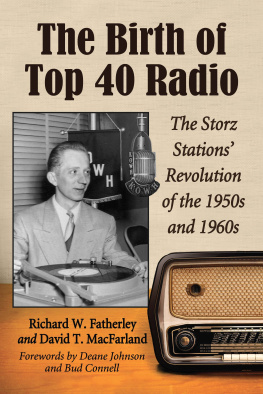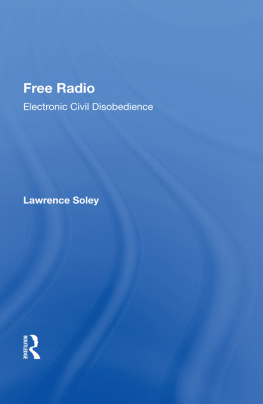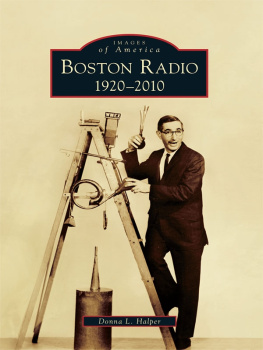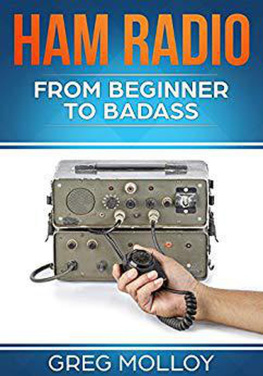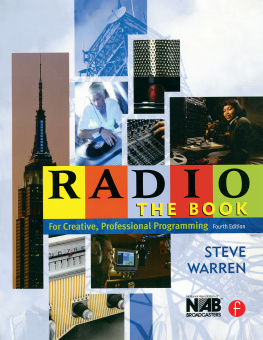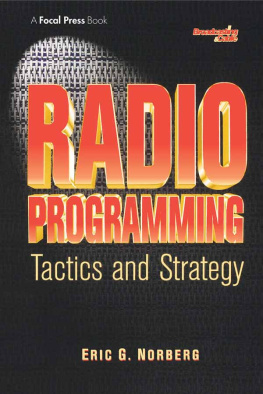
The Birth of Top 40 Radio
The Storz Stations Revolution of the 1950s and 1960s
RICHARD W. FATHERLEY and
DAVID T. MACFARLAND
Forewords by
Deane Johnson and Bud Connell

McFarland & Company, Inc., Publishers
Jefferson, North Carolina
All photographs courtesy Bud Connell.
LIBRARY OF CONGRESS CATALOGUING DATA ARE AVAILABLE
BRITISH LIBRARY CATALOGUING DATA ARE AVAILABLE
e-ISBN: 978-1-4766-0575-3
2014 Richard Ward Fatherley, Jr., and David T. MacFarland. All rights reserved
No part of this book may be reproduced or transmitted in any form or by any means, electronic or mechanical, including photocopying or recording, or by any information storage and retrieval system, without permission in writing from the publisher.
On the cover: Sandy Jackson at KOWH (courtesy Bud Connell); radio and background images (iStockPhoto/Thinkstock)
McFarland & Company, Inc., Publishers
Box 611, Jefferson, North Carolina 28640
www.mcfarlandpub.com
Dedication
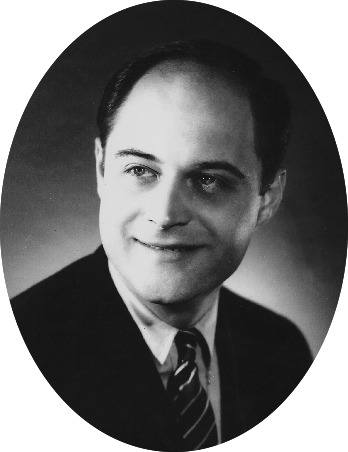
Dick Fatherley in 1968.
Richard W. Fatherley was the original author of this book, but he died of a heart attack before it could be completed.
It seems that few persons anymore are so enraptured, so motivated, or so inspired by the company they work for that they want to write a glowing book about it. Loyalty now, both down from the top and up from the ranks of most organizations, is in short supply. Buy-outs and mergers have made it impossible for employees to get very secure with their current position. It used to be that entire familiesgeneration after generationworked for the same company. My dad, and his father before him, worked at GM, and now I do toobe it in the mine, on the farm, or wherever. Workers had the feeling that the company would last forever, and would take good care of them after they had given it their youth, years of loyalty, and their trust.
The demise of radio was predicted in the middle of the last century by vaunted industrialists like General David Sarnoff of RCA, who stated flatly Lets face it boys, radio is dead. During those dark days of radio in the early 50s, we youngsters were told Anyone with any brains is going into TV. Radio networks collapsed. A lot of talent sought the glamor of television. But if radio was dead, they forgot to bury the body. By 1953 it was discovered that radio sets were the largest-selling electrical appliance in the U.S., and by a wide margin. At the end of that same decade, the number of radios being sold was increasing, not dwindling.
Into radios early-50s malaise had come Todd Storz of Omaha. He would show the industry just how wrong Sarnoff was.
The Storz Broadcasting Company did not become successful because of their business practices, although they were very good. Instead, the Storz formula for success was a precursor of the saying Build it and they will come. That is, provide appealing programming that generates high audience ratings, and the business will almost take care of itself.
Richard Ward Fatherley, who had worked as an announcer and as production director at Storz stations WHB and KXOK, was searching the country for facts about American radio during the last half of the 20th century. He had made it his job to tell the Storz Top 40 story as accurately and as interestingly as he could. Dick had completed 14 short chapters of his intended book before he died suddenly in 2010. His emphasis was on the programming heard on the seven Storz stations in Omaha, New Orleans, Kansas City, Minneapolis, Miami, Oklahoma City, and St. Louis, on how they developed the Storz sound, and how they took the entire radio industry to a whole new level of listener loyalty.
Dick Fatherleys unfinished manuscript is remarkable because he felt compelled to express his love for a company that meant so much to him and his career. He wanted to explain the history-making impact, the innovation, and the lasting influence of the programming of the Storz Broadcasting Companywhat Fatherley called Radios Revolutionand how it helped to save the U.S. radio industry from oblivion in the early 1950s.
Following Dicks passing, four of us thought the story was too good not to be available to a wider audience. Our group was David MacFarland, whose Ph.D dissertation was The Development of the Top 40 Radio Format; Bud Connell, one of the nations most accomplished radio programmers and consultants; Deane Johnson, a former program director of several of the Storz stations; and Jack Sampson, a general manager of several Storz stations, and a more-than-20-year veteran of the Storz organization. We all pledged to continue the research and extend the writing in order to complete the project Dick had started.
It is not known to us exactly what the concluding chapters of Dicks book might have said. What in fact happened to the Storz Broadcasting Company is that after Todd Storz died in 1964, the company took a definite turn from an emphasis on programming, to being a tough, commercial, money-making machine. Partially because of that change, and the fact that all of the Storz properties were AM stations which were destined to lose their audience to the higher fidelity of FM signals, Storz Broadcasting began a steady decline until all of the stations were sold off.
The programming-driven rise and the avoidable fall of the Storz Broadcasting Company is not as important as the fact that the programming sound developed by Storz lives on today. When you tune to some AM stations, many FM signals, certain satellite radio channels, even Pandora on the internet, you hear Storz Broadcastings influence. The real story youll find in these pages is about innovations in radio programming that createdand pleasedentirely new audiences, and which ultimately spawned many successful variations on the original Storz format.
How many times in commencement speeches have speakers told grads to follow your dreams? Thank heaven Todd Storz did, and thank heaven Dick Fatherley did too.
Jack Sampson
Acknowledgments
Grateful appreciation is extended for the help provided by:
Bud Connell, Deane Johnson and Jack Sampson for their innumerable contributions to this book. They offered unique and valuable printed and recorded material from their own archives, personal recollections not documented anywhere else, and unfailing collegiality throughout the writing and editing process. Their accomplishments in radio extend far beyond what this single book can convey.
Prof. Christopher H. Sterling, Research Professor of Media and Public Affairs in the Columbian College of Arts and Sciences at George Washington University, who patiently supplied both additional historical context and essential editorial advice. His counsel has been invaluable.
Kristin Copeland, former Senior Administrative Assistant in the A. Q. Miller School of Journalism and Mass Communications at Kansas State University, who graciously typed several revisions of Richard W. Fatherleys unfinished manuscript, thus making it available in electronic format.
Foreword
BY DEANE JOHNSON
I first became fascinated with radio before I was even in the seventh grade in the small agriculture community of Creston, Iowa. Our local station was KSIB, and it seemed like a magic place that was somehow bigger than life. While I was in junior high, KSIBs man on the street program, broadcast from a nearby business, occupied my attention during the noon-hour break from classes.
Next page
